Abstract
OBJECTIVE: To assess the potential role of positron emission tomography (PET) with 2-[18F]fluoro-2-deoxy-D-glucose (FDG) in patients with unexplained rising carcinoembryonic antigen (CEA) levels after the treatment of colorectal cancer. BACKGROUND: A rising CEA level after the resection of colorectal cancer is an early indicator of tumor recurrence. However, conventional imaging techniques have limited sensitivity for detecting recurrent disease in such patients. Especially after surgical intervention, FDG-PET is rapidly gaining an important role in establishing the extent of disease in the oncology patient. METHODS: Twenty-two patients with abnormal CEA levels and normal results of conventional methods of tumor detection were studied with FDG-PET. The PET results were compared with pathologic findings (n = 9) and long-term radiologic and clinical follow-up (n = 13). RESULTS: FDG-PET was abnormal in 17 of 22 patients. Tissue sampling was available in 7 of these 17 patients; all of these had recurrent disease. Definitive curative surgical intervention was performed in four patients. Subsequent dedicated imaging findings and clinical course confirmed the presence of extensive disease in 8 of the remaining 10 patients; the PET results in the other 2 patients were considered falsely positive. FDG-PET was negative in 5 of 22 patients. No disease was found by tissue sampling (n = 2) and clinical follow-up (n = 3). Overall, the positive-predictive value for PET was 89%, (15 of 17) and the negative-predictive value was 100% (5 of 5). CONCLUSIONS: When conventional examinations are normal, FDG-PET is a valuable imaging tool in patients who have a rising CEA level after colorectal surgery.
Full text
PDF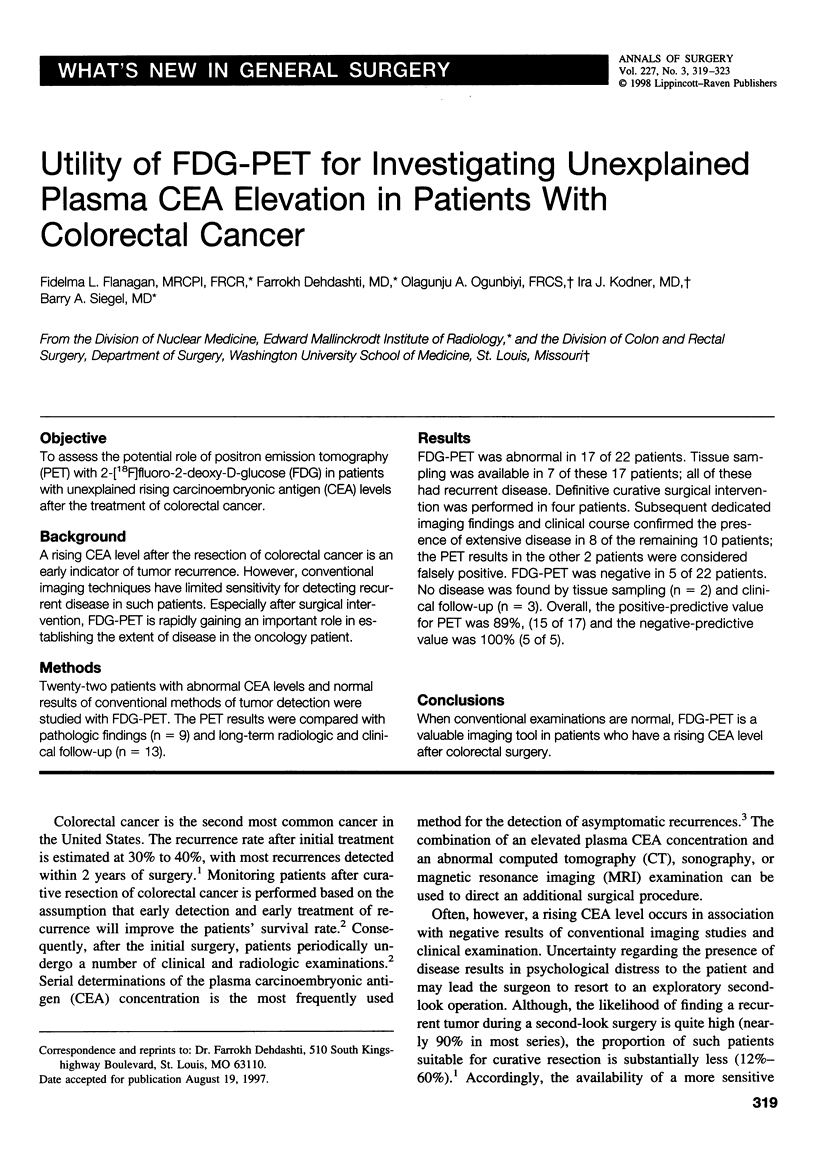
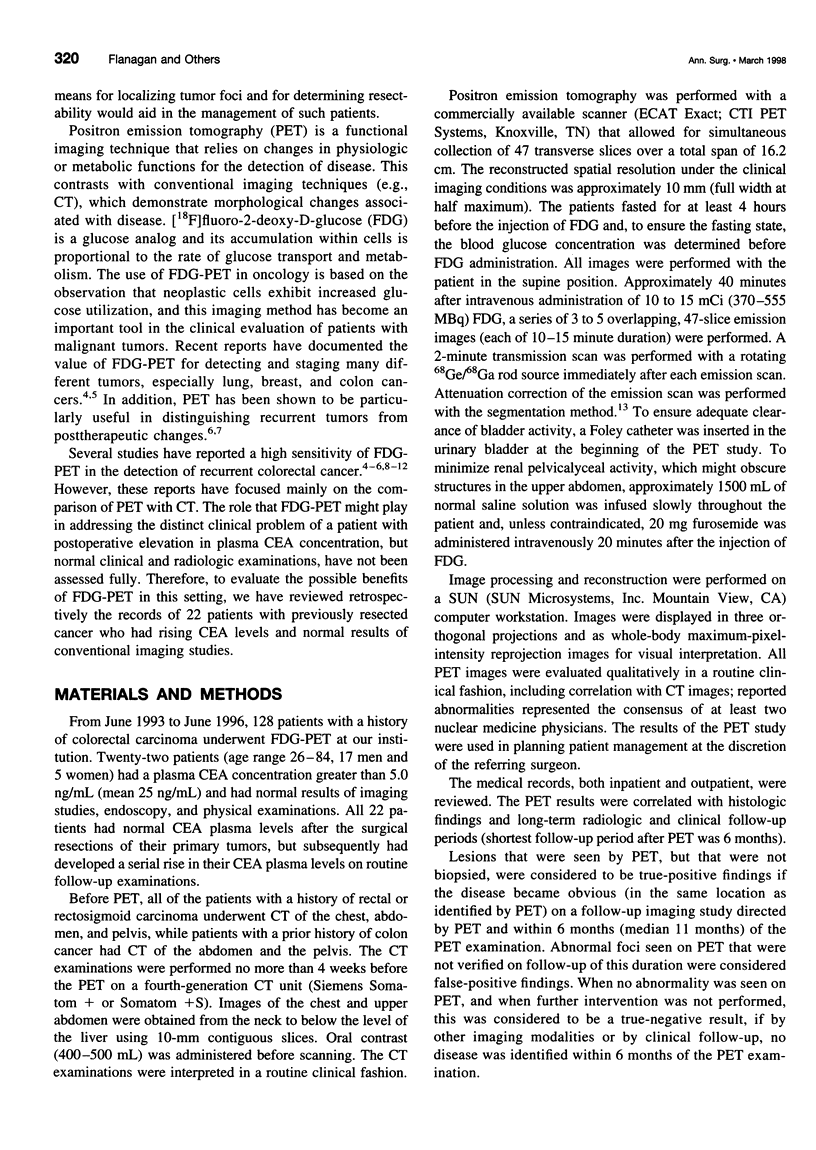
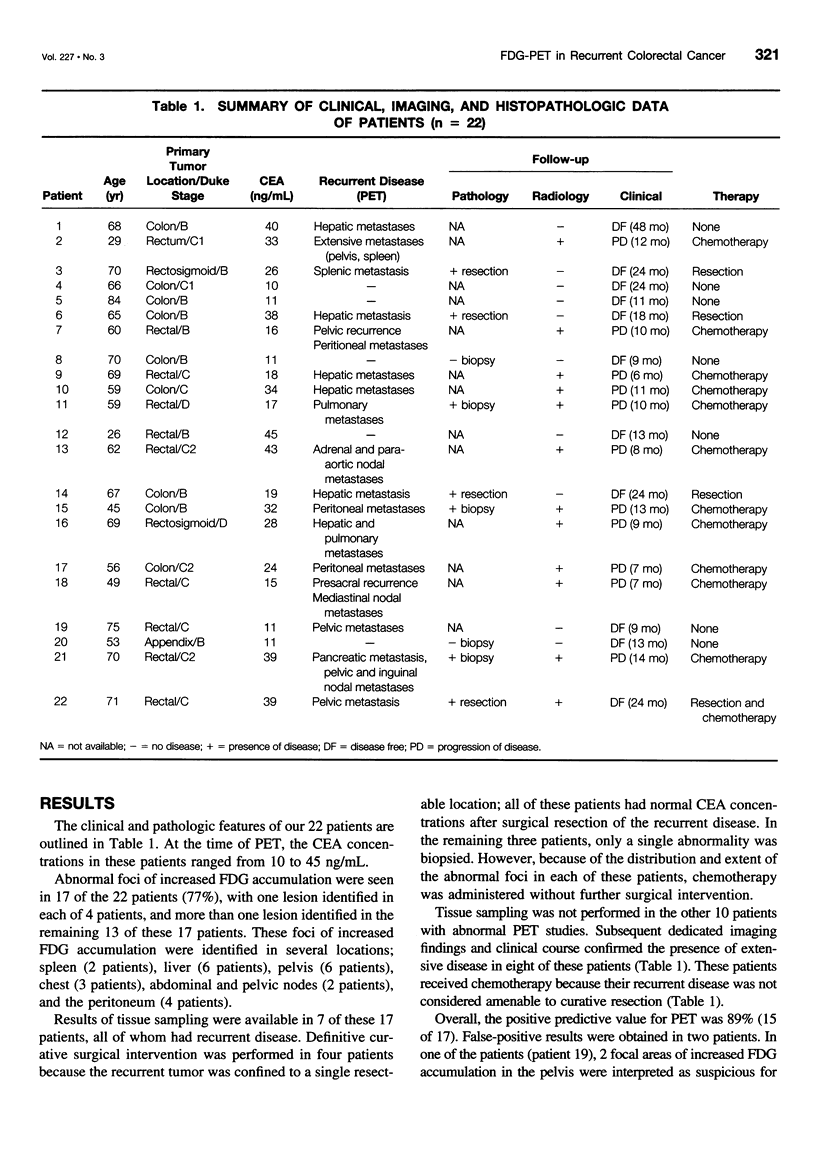
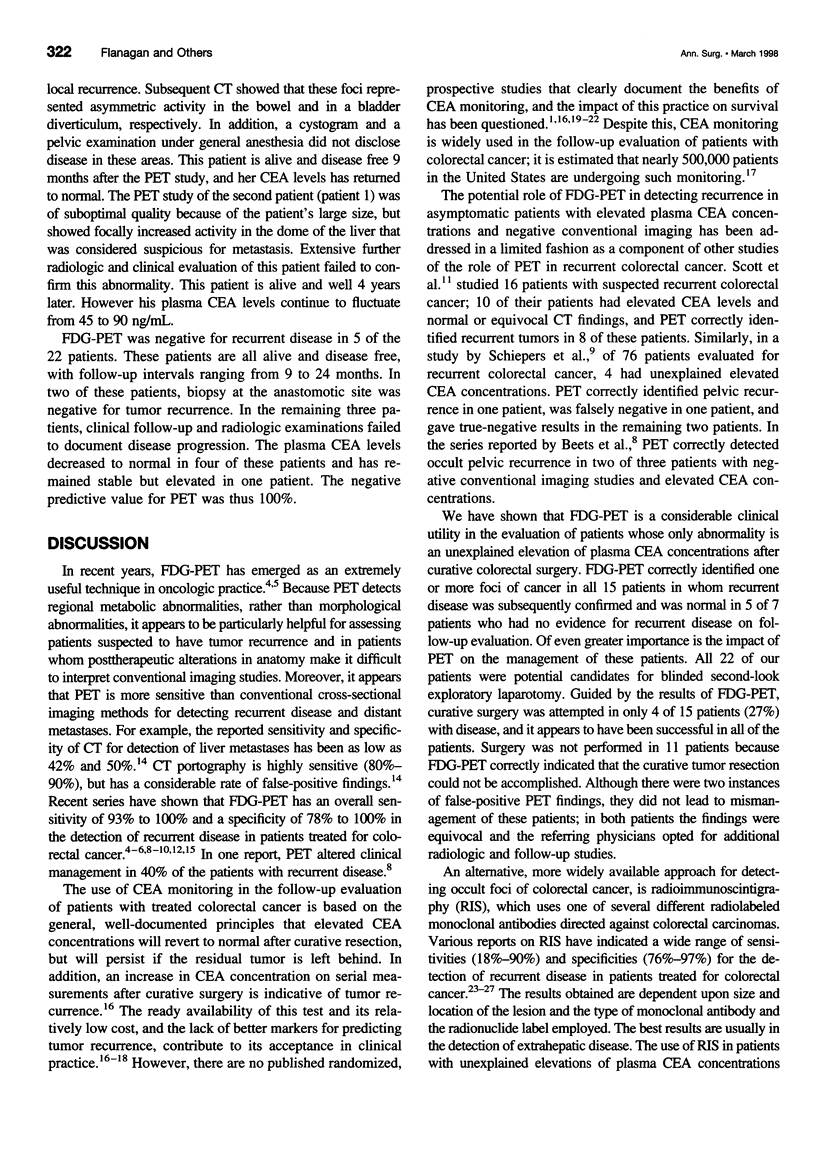
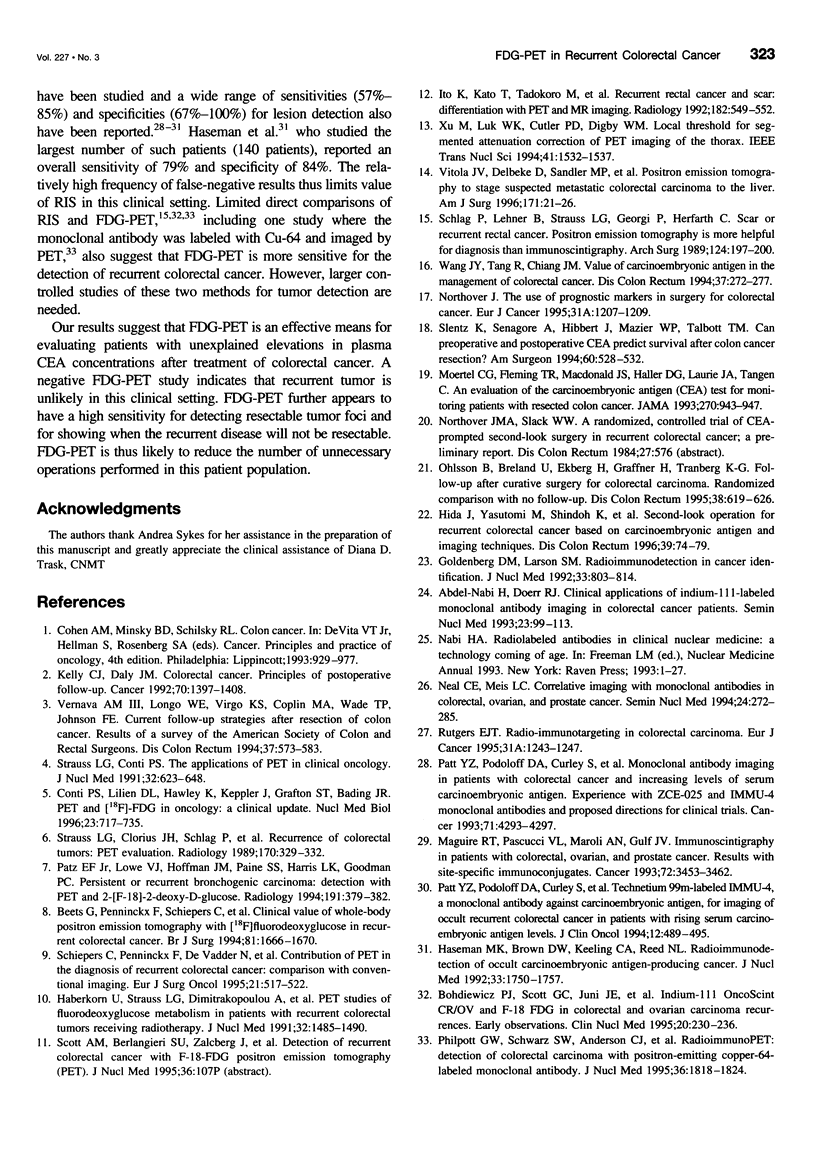
Selected References
These references are in PubMed. This may not be the complete list of references from this article.
- Abdel-Nabi H., Doerr R. J. Clinical applications of indium-111-labeled monoclonal antibody imaging in colorectal cancer patients. Semin Nucl Med. 1993 Apr;23(2):99–113. doi: 10.1016/s0001-2998(05)80091-1. [DOI] [PubMed] [Google Scholar]
- Beets G., Penninckx F., Schiepers C., Filez L., Mortelmans L., Kerremans R., Aerts R., De Roo M. Clinical value of whole-body positron emission tomography with [18F]fluorodeoxyglucose in recurrent colorectal cancer. Br J Surg. 1994 Nov;81(11):1666–1670. doi: 10.1002/bjs.1800811136. [DOI] [PubMed] [Google Scholar]
- Bohdiewicz P. J., Scott G. C., Juni J. E., Fink-Bennett D., Wilner F., Nagle C., Dworkin H. J. Indium-111 OncoScint CR/OV and F-18 FDG in colorectal and ovarian carcinoma recurrences. Early observations. Clin Nucl Med. 1995 Mar;20(3):230–236. doi: 10.1097/00003072-199503000-00009. [DOI] [PubMed] [Google Scholar]
- Conti P. S., Lilien D. L., Hawley K., Keppler J., Grafton S. T., Bading J. R. PET and [18F]-FDG in oncology: a clinical update. Nucl Med Biol. 1996 Aug;23(6):717–735. doi: 10.1016/0969-8051(96)00074-1. [DOI] [PubMed] [Google Scholar]
- Goldenberg D. M., Larson S. M. Radioimmunodetection in cancer identification. J Nucl Med. 1992 May;33(5):803–814. [PubMed] [Google Scholar]
- Haberkorn U., Strauss L. G., Dimitrakopoulou A., Engenhart R., Oberdorfer F., Ostertag H., Romahn J., van Kaick G. PET studies of fluorodeoxyglucose metabolism in patients with recurrent colorectal tumors receiving radiotherapy. J Nucl Med. 1991 Aug;32(8):1485–1490. [PubMed] [Google Scholar]
- Haseman M. K., Brown D. W., Keeling C. A., Reed N. L. Radioimmunodetection of occult carcinoembryonic antigen-producing cancer. J Nucl Med. 1992 Oct;33(10):1750–1756. [PubMed] [Google Scholar]
- Hida J., Yasutomi M., Shindoh K., Kitaoka M., Fujimoto K., Ieda S., Machidera N., Kubo R., Morikawa E., Inufusa H. Second-look operation for recurrent colorectal cancer based on carcinoembryonic antigen and imaging techniques. Dis Colon Rectum. 1996 Jan;39(1):74–79. doi: 10.1007/BF02048273. [DOI] [PubMed] [Google Scholar]
- Ito K., Kato T., Tadokoro M., Ishiguchi T., Oshima M., Ishigaki T., Sakuma S. Recurrent rectal cancer and scar: differentiation with PET and MR imaging. Radiology. 1992 Feb;182(2):549–552. doi: 10.1148/radiology.182.2.1732979. [DOI] [PubMed] [Google Scholar]
- Kelly C. J., Daly J. M. Colorectal cancer. Principles of postoperative follow-up. Cancer. 1992 Sep 1;70(5 Suppl):1397–1408. doi: 10.1002/1097-0142(19920901)70:3+<1397::aid-cncr2820701531>3.0.co;2-a. [DOI] [PubMed] [Google Scholar]
- Maguire R. T., Pascucci V. L., Maroli A. N., Gulfo J. V. Immunoscintigraphy in patients with colorectal, ovarian, and prostate cancer. Results with site-specific immunoconjugates. Cancer. 1993 Dec 1;72(11 Suppl):3453–3462. doi: 10.1002/1097-0142(19931201)72:11+<3453::aid-cncr2820721612>3.0.co;2-#. [DOI] [PubMed] [Google Scholar]
- Moertel C. G., Fleming T. R., Macdonald J. S., Haller D. G., Laurie J. A., Tangen C. An evaluation of the carcinoembryonic antigen (CEA) test for monitoring patients with resected colon cancer. JAMA. 1993 Aug 25;270(8):943–947. [PubMed] [Google Scholar]
- Neal C. E., Meis L. C. Correlative imaging with monoclonal antibodies in colorectal, ovarian, and prostate cancer. Semin Nucl Med. 1994 Oct;24(4):272–285. doi: 10.1016/s0001-2998(05)80019-4. [DOI] [PubMed] [Google Scholar]
- Northover J. The use of prognostic markers in surgery for colorectal cancer. Eur J Cancer. 1995 Jul-Aug;31A(7-8):1207–1209. doi: 10.1016/0959-8049(95)00158-f. [DOI] [PubMed] [Google Scholar]
- Ohlsson B., Breland U., Ekberg H., Graffner H., Tranberg K. G. Follow-up after curative surgery for colorectal carcinoma. Randomized comparison with no follow-up. Dis Colon Rectum. 1995 Jun;38(6):619–626. doi: 10.1007/BF02054122. [DOI] [PubMed] [Google Scholar]
- Patt Y. Z., Podoloff D. A., Curley S., Kasi L., Smith R., Bhadkamkar V., Charnsangavej C. Technetium 99m-labeled IMMU-4, a monoclonal antibody against carcinoembryonic antigen, for imaging of occult recurrent colorectal cancer in patients with rising serum carcinoembryonic antigen levels. J Clin Oncol. 1994 Mar;12(3):489–495. doi: 10.1200/JCO.1994.12.3.489. [DOI] [PubMed] [Google Scholar]
- Patt Y. Z., Podoloff D. A., Curley S., Smith R., Badkhamkar V. A., Lamki L. M., Jessup M. M., Hohn D. C. Monoclonal antibody imaging in patients with colorectal cancer and increasing levels of serum carcinoembryonic antigen. Experience with ZCE-025 and IMMU-4 monoclonal antibodies and proposed directions for clinical trials. Cancer. 1993 Jun 15;71(12 Suppl):4293–4297. doi: 10.1002/1097-0142(19930615)71:12+<4293::aid-cncr2820711818>3.0.co;2-r. [DOI] [PubMed] [Google Scholar]
- Patz E. F., Jr, Lowe V. J., Hoffman J. M., Paine S. S., Harris L. K., Goodman P. C. Persistent or recurrent bronchogenic carcinoma: detection with PET and 2-[F-18]-2-deoxy-D-glucose. Radiology. 1994 May;191(2):379–382. doi: 10.1148/radiology.191.2.8153309. [DOI] [PubMed] [Google Scholar]
- Philpott G. W., Schwarz S. W., Anderson C. J., Dehdashti F., Connett J. M., Zinn K. R., Meares C. F., Cutler P. D., Welch M. J., Siegel B. A. RadioimmunoPET: detection of colorectal carcinoma with positron-emitting copper-64-labeled monoclonal antibody. J Nucl Med. 1995 Oct;36(10):1818–1824. [PubMed] [Google Scholar]
- Rutgers E. J. Radio-immunotargeting in colorectal carcinoma. Eur J Cancer. 1995 Jul-Aug;31A(7-8):1243–1247. doi: 10.1016/0959-8049(95)00143-7. [DOI] [PubMed] [Google Scholar]
- Schiepers C., Penninckx F., De Vadder N., Merckx E., Mortelmans L., Bormans G., Marchal G., Filez L., Aerts R. Contribution of PET in the diagnosis of recurrent colorectal cancer: comparison with conventional imaging. Eur J Surg Oncol. 1995 Oct;21(5):517–522. doi: 10.1016/s0748-7983(95)97046-0. [DOI] [PubMed] [Google Scholar]
- Schlag P., Lehner B., Strauss L. G., Georgi P., Herfarth C. Scar or recurrent rectal cancer. Positron emission tomography is more helpful for diagnosis than immunoscintigraphy. Arch Surg. 1989 Feb;124(2):197–200. doi: 10.1001/archsurg.1989.01410020067011. [DOI] [PubMed] [Google Scholar]
- Slentz K., Senagore A., Hibbert J., Mazier W. P., Talbott T. M. Can preoperative and postoperative CEA predict survival after colon cancer resection? Am Surg. 1994 Jul;60(7):528–532. [PubMed] [Google Scholar]
- Strauss L. G., Clorius J. H., Schlag P., Lehner B., Kimmig B., Engenhart R., Marin-Grez M., Helus F., Oberdorfer F., Schmidlin P. Recurrence of colorectal tumors: PET evaluation. Radiology. 1989 Feb;170(2):329–332. doi: 10.1148/radiology.170.2.2783494. [DOI] [PubMed] [Google Scholar]
- Strauss L. G., Conti P. S. The applications of PET in clinical oncology. J Nucl Med. 1991 Apr;32(4):623–650. [PubMed] [Google Scholar]
- Vernava A. M., 3rd, Longo W. E., Virgo K. S., Coplin M. A., Wade T. P., Johnson F. E. Current follow-up strategies after resection of colon cancer. Results of a survey of members of the American Society of Colon and Rectal Surgeons. Dis Colon Rectum. 1994 Jun;37(6):573–583. doi: 10.1007/BF02050993. [DOI] [PubMed] [Google Scholar]
- Vitola J. V., Delbeke D., Sandler M. P., Campbell M. G., Powers T. A., Wright J. K., Chapman W. C., Pinson C. W. Positron emission tomography to stage suspected metastatic colorectal carcinoma to the liver. Am J Surg. 1996 Jan;171(1):21–26. doi: 10.1016/S0002-9610(99)80067-1. [DOI] [PubMed] [Google Scholar]
- Wang J. Y., Tang R., Chiang J. M. Value of carcinoembryonic antigen in the management of colorectal cancer. Dis Colon Rectum. 1994 Mar;37(3):272–277. doi: 10.1007/BF02048166. [DOI] [PubMed] [Google Scholar]


